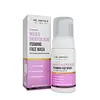What's inside
What's inside
 Key Ingredients
Key Ingredients

No key ingredients
 Benefits
Benefits

 Concerns
Concerns

 Ingredients Side-by-side
Ingredients Side-by-side

Water
Skin ConditioningCocamidopropyl Betaine
CleansingSodium Lauroyl Sarcosinate
CleansingDisodium Cocoamphodiacetate
CleansingDecyl Glucoside
CleansingSodium Methyl Cocoyl Taurate
CleansingSalicylic Acid
MaskingGlycerin
HumectantSodium C14-16 Olefin Sulfonate
CleansingSodium Cocoamphoacetate
CleansingCocamide Mea
EmulsifyingXylitol
HumectantGlucose
HumectantAnhydroxylitol
HumectantNopalea Cochenillifera Extract
Skin ConditioningPolysorbate 20
EmulsifyingAzadirachta Indica Leaf Extract
Skin ConditioningSodium Hydroxide
BufferingPhenoxyethanol
PreservativeEthylhexylglycerin
Skin ConditioningGuar Hydroxypropyltrimonium Chloride
Skin ConditioningOcimum Sanctum Leaf Extract
Skin ConditioningFucus Vesiculosus Extract
EmollientButylene Glycol
Humectant1,2-Hexanediol
Skin ConditioningHydroxyacetophenone
AntioxidantXanthan Gum
EmulsifyingCaprylyl Glycol
EmollientHydrolyzed Wheat Protein
Skin ConditioningHydrolyzed Soy Protein
HumectantPectin
Emulsion StabilisingArginine
MaskingProline
Skin ConditioningSerine
MaskingChondrus Crispus Extract
Skin ConditioningTocopherol
AntioxidantPanthenol
Skin ConditioningCitric Acid
BufferingSodium Hyaluronate
HumectantPotassium Sorbate
PreservativeWater, Cocamidopropyl Betaine, Sodium Lauroyl Sarcosinate, Disodium Cocoamphodiacetate, Decyl Glucoside, Sodium Methyl Cocoyl Taurate, Salicylic Acid, Glycerin, Sodium C14-16 Olefin Sulfonate, Sodium Cocoamphoacetate, Cocamide Mea, Xylitol, Glucose, Anhydroxylitol, Nopalea Cochenillifera Extract, Polysorbate 20, Azadirachta Indica Leaf Extract, Sodium Hydroxide, Phenoxyethanol, Ethylhexylglycerin, Guar Hydroxypropyltrimonium Chloride, Ocimum Sanctum Leaf Extract, Fucus Vesiculosus Extract, Butylene Glycol, 1,2-Hexanediol, Hydroxyacetophenone, Xanthan Gum, Caprylyl Glycol, Hydrolyzed Wheat Protein, Hydrolyzed Soy Protein, Pectin, Arginine, Proline, Serine, Chondrus Crispus Extract, Tocopherol, Panthenol, Citric Acid, Sodium Hyaluronate, Potassium Sorbate
Salicylic Acid
MaskingSodium Cocoamphoacetate
CleansingHexylene Glycol
EmulsifyingCocamidopropyl Betaine
CleansingPEG-12 Dimethicone
Skin ConditioningGlycerin
HumectantPPG-2 Hydroxyethyl Coco/Isostearamide
PEG-120 Methyl Glucose Dioleate
EmulsifyingSodium Benzoate
MaskingSodium Citrate
BufferingPhenoxyethanol
PreservativeMethylparaben
PreservativeTetrasodium EDTA
Parfum
MaskingSodium Hydroxide
BufferingWater
Skin ConditioningIngredients Explained
These ingredients are found in both products.
Ingredients higher up in an ingredient list are typically present in a larger amount.
Cocamidopropyl Betaine is a fatty acid created by mixing similar compounds in coconut oil and dimethylaminopropylamine, a compound with two amino groups.
This ingredient is a surfactant and cleanser. It helps gather the dirt, pollutants, and other impurities in your skin to be washed away. It also helps thicken a product and make the texture more creamy.
Being created from coconut oil means Cocamidopropyl Betaine is hydrating for the skin.
While Cocamidopropyl Betaine was believed to be an allergen, a study from 2012 disproved this. It found two compounds in unpure Cocamidopropyl Betaine to be the irritants: aminoamide and 3-dimethylaminopropylamine. High-grade and pure Cocamidopropyl Betaine did not induce allergic reactions during this study.
Learn more about Cocamidopropyl BetaineGlycerin is already naturally found in your skin. It helps moisturize and protect your skin.
A study from 2016 found glycerin to be more effective as a humectant than AHAs and hyaluronic acid.
As a humectant, it helps the skin stay hydrated by pulling moisture to your skin. The low molecular weight of glycerin allows it to pull moisture into the deeper layers of your skin.
Hydrated skin improves your skin barrier; Your skin barrier helps protect against irritants and bacteria.
Glycerin has also been found to have antimicrobial and antiviral properties. Due to these properties, glycerin is often used in wound and burn treatments.
In cosmetics, glycerin is usually derived from plants such as soybean or palm. However, it can also be sourced from animals, such as tallow or animal fat.
This ingredient is organic, colorless, odorless, and non-toxic.
Glycerin is the name for this ingredient in American English. British English uses Glycerol/Glycerine.
Learn more about GlycerinPhenoxyethanol is a preservative that has germicide, antimicrobial, and aromatic properties. Studies show that phenoxyethanol can prevent microbial growth. By itself, it has a scent that is similar to that of a rose.
It's often used in formulations along with Caprylyl Glycol to preserve the shelf life of products.
Salicylic Acid (also known as beta hydroxy acid or BHA) is a well-known ingredient for treating skin that struggles with acne and clogged pores. It exfoliates both the skin's surface and deep within the pores to help clear out buildup, control oil, and reduce inflammation.
Unlike AHAs (alpha hydroxy acids), salicylic acid is oil-soluble. This allows it to penetrate into pores which makes it especially effective for treating blackheads and preventing future breakouts.
Salicylic acid is also known for its soothing properties. It has a similar structure to aspirin and can calm inflamed or irritated skin, making it a good option for acne-prone skin that is also sensitive.
Concentrations of 0.5-2% are recognized by the U.S. FDA as an over-the-counter topical acne product.
It can cause irritation and/or dryness if one's skin already has a compromised moisture barrier, so it's best to focus on repairing that before introducing this ingredient into your routine.
While salicylic acid does not increase sun sensitivity, it’s still important to wear sunscreen daily to protect your skin.
If you are looking for the ingredient called BHA or Butylated Hydroxyanisole, click here.
Learn more about Salicylic AcidWe don't have a description for Sodium Cocoamphoacetate yet.
Sodium Hydroxide is also known as lye or caustic soda. It is used to adjust the pH of products; many ingredients require a specific pH to be effective.
In small amounts, sodium hydroxide is considered safe to use. However, large amounts may cause chemical burns due to its high alkaline.
Your skin has a natural pH and acid mantle. This acid mantle helps prevent harmful bacteria from breaking through. The acid mantle also helps keep your skin hydrated.
"Alkaline" refers to a high pH level. A low pH level would be considered acidic.
Learn more about Sodium HydroxideWater. It's the most common cosmetic ingredient of all. You'll usually see it at the top of ingredient lists, meaning that it makes up the largest part of the product.
So why is it so popular? Water most often acts as a solvent - this means that it helps dissolve other ingredients into the formulation.
You'll also recognize water as that liquid we all need to stay alive. If you see this, drink a glass of water. Stay hydrated!
Learn more about Water